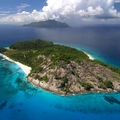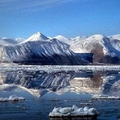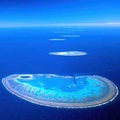World Tourism / The Oceans of the World / The Pacific Ocean
The Pacific Ocean
In the XV century, people called it " the Great Ocean , " and it was already assumed that it is an ocean of boundless amount. And they were right, because the area of the Pacific Ocean is more than 178.620 million km ². It occupies half of the entire water surface of the Earth, and over thirty percent of the planet's surface. The Spanish conquistador Vasco Nunez de Balboa found the ocean for the first time. On October 2, in 1513 he reached the ocean and christened it the Great Southern Sea . Here begins the history of the ocean. The Pacific Ocean was named so by the famous explorer Magellan . This was the first European explorer who could safely cross the ocean. Fernando Magellan , making its journey around the world, spent more than three months in the uncharted water ocean. Having experienced many terrible storms during his expedition, Magellan named it the Pacific Ocean. He also compiled the first detailed map of the ocean sea.
Facts and Figures
Area: 178.7 million square kilometers.
The maximum width: 23.945 km
The average depth: 3976 m
The maximum depth: Mariana Trench (11.022 meters)
Mineral resources: oil, natural gas. Marine fisheries: fish, shellfish, seals, seaweed, pearls
The largest island: New Guinea
General information
The Pacific Ocean is twice the Atlantic Ocean in size. It occupies 165 million square kilometers which is almost half the entire area of the oceans. It contains more than half of all water on the planet. At one point, this ocean extends for 17 km in width, stretching for nearly half of the globe. Despite its name, this vast ocean is not just blue, beautiful and serene. Severe storms and underwater earthquakes led it into rage. In fact, there are large zones of seismic activity in the Pacific.
Description
The Pacific Ocean is the largest ocean in the world and it covers one-third of the planet's surface. Its waters extend from East Asia and Africa to America. The Pacific Ocean is on average 120 meters in its most shallow depth. These waters wash the so-called continental shelves, which are flooded parts of the continental platforms, starting from the shoreline and gradually leaving the water. In general, the depth of the Pacific Ocean is on average 4000 meters. Depressions in the west are united in the deepest and the darkest place in the world - the Mariana Trench - 11 022 m used to be that at this depth, there is no life. But even there, scientists have found living organisms! A high ridge of underwater mountains and a huge part of the Earth’s crust are situated on the Pacific. A lot of volcanic islands such as Hawaii, the largest island of the archipelago of the Hawaiian Islands also belong to the Pacific Ocean. Hawaii is the highest mountain in the world - the mountain of Mauna Kea. It is a dormant volcano 10,000 feet high from the base at the bottom of the sea. In contrast to the volcanic islands there are low-lying islands formed by coral deposits, which are superimposed over the millennia on the tops of underwater volcanoes. This vast ocean is inhabited by representatives of a variety of underwater world - from the world's largest fish (whale sharks) before flying fish, squid and sea lions. The warm shallow water coral reefs are home to thousands of species of brightly-colored fish and seaweed. All sorts of fish, marine mammals, molluscs, crustaceans and other creatures float in the cool deep waters.
People and history
Boat trips across the Pacific Ocean date back to antiquity. Around 40,000 years ago Aboriginal people had crossed by canoe from New Guinea to Australia. Centuries later, between the XVI century B.C. the Polynesian peoples settled on the Pacific Islands, daring to overcome enormous water distance. This is considered one of the greatest achievements in the history of navigation. Using special double-bottomed canoes and woven from the leaves of the sails, the Polynesian navigators crossed eventually nearly 20 million square meters, miles of the ocean’s space. Around the XII century the Chinese advanced and developed the art of marine navigation in the Western Pacific Ocean. They were the first who started to use larger ships with several masts located on the underwater part of the ship, steering, and compasses.
The Europeans began to study the Pacific Ocean in the XVII century, when the Dutch captain Abel Tasman Yanszon rounded on his ship, in Australia and New Zealand . One of the most famous explorers of the Pacific is Captain is James Cook. Between the 1768 and the 1779 year, he charted the New Zealand east coast of Australia and many Pacific Islands. In 1947, the Norwegian explorer Thor Heyerdahl sailed on his raft "Kon-Tiki" from the coast of Peru to the Tuamotu Archipelago, part of French Polynesia . His expedition was the proof that the ancient indigenous inhabitants of South America could cross the vast ocean distances on rafts. In the twentieth century the study on the Pacific continued. Mariana Trench, as well as unknown species of marine animals and plants had been living in the ocean. The development of the tourism industry, environmental pollution and the device beaches threatened the natural balance of the Pacific. National governments and environmental groups tried to minimize the harm to our civilization and of the aquatic environment.
The economic importance
The important sea and air communication between the countries of the Pacific Basin and the transit routes between the Atlantic and Indian Oceans lie across the Pacific Ocean. Here are the major ports of Vladivostok, Nakhodka (Russia), Shanghai (China) and Singapore. The major oil pipeline "Eastern Siberia of Russia is also in the Pacific Ocean". Because of the huge number of transport cargo in the Pacific Ocean, there are many pirates. There is a real war in the coastal areas of the Fiji Islands among them. However, the Pacific Ocean is economically important not only for traders and pirates, but the films " The Pirates of the Pacific," "Lorelei: the Witch of the Pacific" and many others have always had a huge success . Many of the islands of the ocean are available and habited. You can relax on vacation on an island in the Pacific. By the way, in addition, you can earn good money, for the pictures with the inhabitants of the Pacific are very searched.
Others The Oceans of the World .
Maps of The Pacific Ocean
mapOthers from The Oceans of the World
Life depends crucially, more than ever, on the respect that people will have to the oceans.
They are and will remain the cradle of life.
A romance voyage with saturated air, breathing the sea air is a necessary condition for a quality rest.
This improves the immunity of the person and receives a charge of vivacity enough for a few months.
The sea air, rich in iodine salts, sodium chloride promotes cell regeneration and the slowing of the aging process.
The sea calms, the sound of the waves, and the vast expanse of the water that a person can watch endlessly is good for our health.
When combined with new experiences, excursions and trips, sea and ocean tours give a great therapeutic effect.
The oceans and the seas, the rivers, the lakes and the streams cover 75% of the surface of our planet.
The amazing underwater world attracts many travelers.
In the past, a travel was associated with the seas and oceans.
Geographical discoveries are inextricably linked with the travelers.
The world knows them since the Middle Ages and starting the list with Columbus and ending with Heyerdalom and Jacques-Yves Cousteau.
Hydrosphere is the collection of all water bodies of the world: oceans , rivers , lakes , reservoirs, wetlands, groundwater, glaciers.
Water is the basis of the hydrosphere, one of the most common chemical compounds on the Earth.
This is the only substance that under natural conditions on the surface of our planet is found in solid, liquid or gaseous state.
It is the main component of the living organisms.
Water body is the permanent or the temporary concentration of the natural waters on the land surface or in rocks with distinctive forms of distribution and features of the regime.
Water bodies are the seas, oceans, rivers, lakes, marshes, reservoirs, groundwater, and water channels, ponds and other places of constant concentration of water on the land surface (in the form of snow).
The world ocean is the bulk of the hydrosphere, a continuous aqueous envelope of the earth surrounding the continents and islands distinguished by a salt composition.
The oceans are regulators of the heat.
Oceans are rich in food, mineral and energy resources.
The boundaries between oceans have been established by the International Hydrographic Organization , so the Antarctic Ocean coast extends from Antarctica to 60 degrees latitude.
One billion people ( 17% of the population) depend directly on the ocean as the only source of protein.
Between 70 – 80% of oxygen is produced by the oceans.
The word ocean from the Greek “ Ωκεανός” , on behalf of the Greek god of the Ocean is the largest water body, a component of the World Ocean , located among the continents , which has a system of water circulation and other special features.
The surface area of the world's oceans, which consist of oceans and seas is about 75 % of the surface of the Earth (about 361 million square kilometers).
The science that studies the oceans is called oceanography .
In 2000, the International Hydrographic Organization adopted a division into five oceans of the world .
However, later on the provision of a separate Southern Ocean refused, and it is now officially back on the Earth’s four oceans: The Atlantic Ocean Area: 91 million km 2 Size: 329.
7 million km 3 Average depth: 3600 meters Maximum depth: 8742 meters The Indian Ocean Area: 73 million km 2 Volume: 292.
1 km 3 Average depth: 3890 meters Maximum depth: 7725 meters The Arctic Ocean Area: 14 000 000 km 2 Volume: 18.
1 km 3 Average depth: 1225 meters Maximum depth: 5527 meters The Pacific Ocean Area: 169 million km 2 Size: 710 km 3 Average depth: 4280 meters Maximum depth: 11 022 m The largest of these is the Pacific Ocean, an area of approximately 169 million square km, the Atlantic Ocean, which area is 91 million square km is the third largest ocean, the Indian and the smallest ocean - the Arctic, an area of approximately 14 million square km.
The oceans are deep waters.
If the surface of the ocean is warmed up by the sun, at the depth, its temperature can fall and fall , even below -1 C.
The water in all parts of the vast ocean is never quiet, constantly moving.
Such movements of the water over long distances are called currents.
The currents are of several types: superficial, deep and bottom.
The main reason for the surface currents (drift) is a breeze.
The sun, the chemical transformations and the attraction of the moon are reasons for the movement of water in the ocean.
The colder or the saltier water .
So, for example, when dealing with warm water, the cold goes into the depths.
Thus deep and bottom currents can be formed.
The Russian Admiral Makarov scientist discovered in the XIX century an undercurrent in the Bosporus.
He found that the more saline waters of the Marmara Sea flows into the Black Sea current , less saline water is carried by the current from the Black Sea of Marmara.
There are ocean currents that arise due to the inclination of the sea level.
These include, in particular, to Florida for the Caribbean, which is formed as a result of the surge of the water over the surface in the Gulf of Mexico.
We cannot know the answer to the question about the formation of the seas and oceans on the planet.
Some scholars suggest that they arose in the following way.
After the appearance of the planet, the Earth was surrounded by a thick blanket of clouds.
Gradually, the Earth cooled and long rains poured on the surface, which filled with water all the cavities in the earth's crust.
Thus, the oceans and the seas were formed.
Later, when the continents began to move, all moving from each other, the water began to fill the distance between them.
So they formed the oceans, which are available now.











